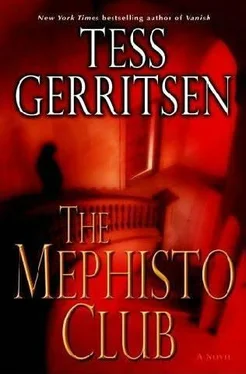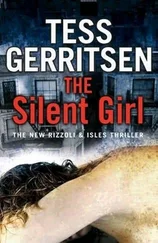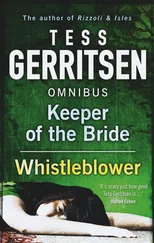“You mean on the top of the pyramid?”
“Right. Their so-called proof that the world’s finances are run by worshippers of Satan.”
“So we’re back to satanic symbols,” said Jane.
“That’s one interpretation.”
“What others are there?”
“This is also a symbol used by the ancient fraternity of Freemasons. In which case it has quite a benign meaning. For them, it symbolizes enlightenment, illumination.”
“The seeking of knowledge,” said Edwina. “It’s about learning the secrets of their craft.”
Jane said, “You’re saying this murder was done by a Freemason?”
“Good grief, no!” said Oliver. “That’s not at all what I’m saying. The poor Freemasons have been the target of so many malicious accusations, I’m not even going to repeat them. I’m just giving you a quick history lesson. This is my field, you know, the interpretation of symbols. I’m trying to explain that this symbol, Udjat, is quite an old one. It’s been used throughout history for various purposes. For some people, its meaning is sacred. For others, it’s terrifying, a symbol of evil. But its original meaning, in the time of ancient Egypt, was quite a bit less threatening. And rather practical.”
“What did it mean then?”
“It represented the eye of Horus, the sun god. Horus is usually depicted in paintings or sculptures as a falcon’s head on a man’s body. He was personified on earth by the Pharaoh.”
Jane sighed. “So it could be a satanic symbol, or a symbol for illumination. Or the eye of some Egyptian god with a bird’s head.”
“There’s yet another possibility.”
“I thought you’d say that.”
Oliver picked up the pen again and drew another variation of the eye. “This symbol,” he said, “came into use in Egypt around 1200 B.C. It’s found in hieratic script.”
“Is that still the eye of Horus?” asked Frost.
“Yes, but notice how the eye is now made up of separate sections. The iris is represented by this circle, between two halves of the sclera. Then there’s the teardrop and the curling lash, as you called it. It looks like just a stylized version of Udjat, but it actually had a very practical use, as a mathematical symbol. Each part of the eye represents a fraction.” He wrote numbers on the sketch now:
“These fractions arise by dividing subsequent numbers in half. The entire eye represents the whole number, one. The left half of the sclera represents the fraction one half. The eyelash is one thirty-second.
“Are we getting around to some kind of point here?” asked Jane.
“Of course.”
“And that would be?”
“That maybe there’s a specific message in this eye. In the first death scene, the severed head was enclosed by a circle. In the second scene, there’s a drawing of Udjat on the door. What if they’re connected, those two symbols? What if one symbol was supposed to be the key to interpreting the other?”
“A mathematical key, you mean?”
“Yes. And the circle, at the first killing, represented an element of Udjat.”
Jane frowned at Oliver’s sketches, at the numbers he had jotted in the various sections of the all-seeing eye. “You’re saying that the circle at the first killing is really supposed to be the iris.”
“Yes. And it has a value.”
“You mean it represents a number? A fraction.” She looked up at Oliver and saw that he was leaning toward her, a flush of excitement in his cheeks.
“Exactly,” he said. “And that fraction would be?”
“One fourth,” she said.
“Right.” He smiled. “Right.”
“One fourth of what?” asked Frost.
“Oh, that we don’t know yet. It could mean a quarter moon. Or one of the four seasons.”
“Or it could mean he’s completed only a quarter of his task,” said Edwina.
“Yes,” said Oliver. “Maybe he’s telling us there are more kills to come. That he’s planning a total of four.”
Jane looked at Frost. “There were four place settings at the dining table.”
In the pause that followed, the ringing of Jane’s cell phone sounded startlingly loud. She recognized the number for the crime-scene lab and answered it at once.
“Rizzoli.”
“Hi, Detective. It’s Erin in Trace Evidence. You know that red circle that was drawn on the kitchen floor?”
“Yeah. We’re talking about it right now.”
“I’ve compared that pigment with the symbols from the Beacon Hill crime scene. The drawings on the door. The pigments do match.”
“So our perp used the same red chalk at both scenes.”
“Well, that’s why I’m calling. It’s not red chalk.”
“What is it?”
“It’s something a lot more interesting.”
The crime lab was in the south wing of Boston PD’s Schroeder Plaza, right down the hallway from the homicide unit offices. The walk took Jane and Frost past windows that looked out over the tired and broken neighborhood of Roxbury. Today, under a cloak of snow, all was purified and white; even the sky had been cleansed, the air crystalline. But that sparkling view of skyline drew only a glance from Jane; her focus was on Room S269, the trace evidence lab.
Criminalist Erin Volchko was waiting for them. As soon as Jane and Frost walked into the room, she swiveled around from the microscope that she’d been hunched over and swept up a file that was sitting on the countertop. “You two owe me a stiff drink,” she said, “after all the work I put into this one.”
“You always say that,” said Frost.
“This time I mean it. Out of all the trace evidence that came in from that first scene, I thought this would be the one we’d have the least trouble with. Instead, I had to chase all over the place to find out what that circle was drawn with.”
“And it’s not plain old chalk,” said Jane.
“Nope.” Erin handed her the folder. “Take a look.”
Jane opened the file. On top was a photographic sheet with a series of images. Red blobs on a blurred background.
“I started with high-magnification light microscopy,” said Erin. “About 600X to 1000X. Those blobs you see there are pigment particles, collected from the red circle drawn on the kitchen floor.”
“So what does this mean?”
“A few things. You can see there are varying degrees of color. The particles aren’t uniform. The refractive index also varied, from 2.5 to 3.01, and many of those particles are birefringent.”
“Meaning?”
“Those are anhydrous iron oxide particles. A quite common substance found around the world. It’s what gives clay its distinctive hues. It’s used in artists’ pigments to produce the colors red, yellow, and brown.”
“That doesn’t sound like anything special.”
“That’s what I thought, until I dug deeper into the subject. I assumed it came from a piece of chalk or a pastel crayon, so I ran comparisons against samples we obtained from two local artists’ supply stores.”
“Any matches?”
“None. The difference was immediately apparent under the microscope. First, the red pigment granules in the pastel crayons showed far less variability in color and refractive index. That’s because most anhydrous iron oxide used in pigments today is synthetic-manufactured, not mined from the earth. They commonly use a compound called Mars Red, a mixture of iron and aluminum oxides.”
“So these pigment granules here, in this photo, aren’t synthetic?”
“No, this is naturally occurring anhydrous iron oxide. It’s also called hematite, derived from the Greek word for blood. Because it’s sometimes red.”
“Do they use the natural stuff in art supplies?”
“We did find a few specialty chalks and pastel crayons that use natural hematite as a pigment. But chalks contain calcium carbonate. And manufactured pastel crayons usually use a natural glue to bind the pigment. Some kind of starch, like methyl cellulose or gum tragacanth. It’s all mixed together into a paste, which is then extruded through a mold to make crayons. We found no traces of gum tragacanth or any binding starch in the crime-scene samples. Nor did we find enough calcium carbonate to indicate that this came from colored chalk.”
Читать дальше












